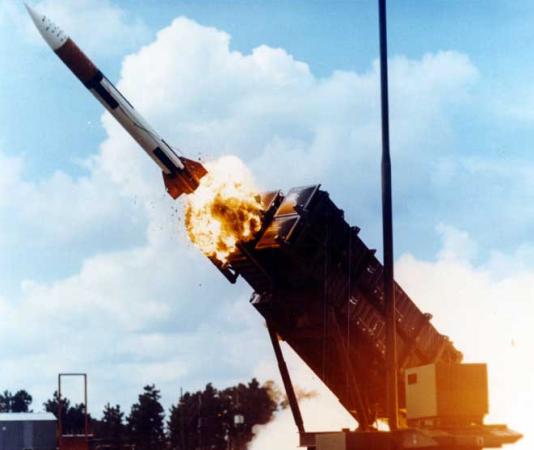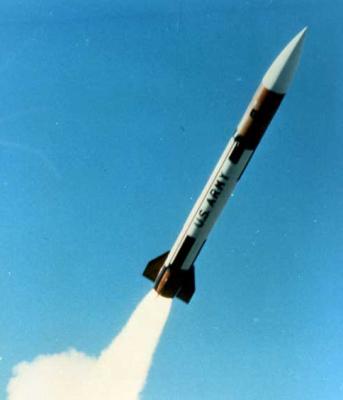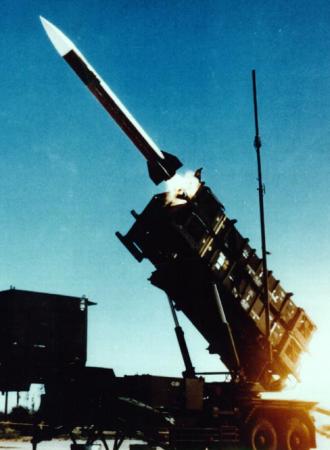Raytheon MIM-104 Patriot
The MIM-104 Patriot is the most advanced medium/long-range surface-to-air missile in current operational U.S. Army inventory. The Patriot system, complemented by the new PAC-3 missile, will remain the Army's main tactical air-defense system for some time in the future.
Studies for an advanced surface-to-air missile to supplement and eventually replace the MIM-23 Hawk already began in 1961 under the FABMDS (Field Army Ballistic Missile Defense System) program. The name was later changed to AADS-70 (Army Air-Defense System - 1970), and finally in 1964 to SAM-D (Surface-to-Air Missile - Development). Specifications were vague and changed frequently, but always included not only the ability to counter aircraft threats of all types, but also an anti-TBM (Theater Ballistic Missiles, a.k.a. short-range ballistic missiles) capability. In May 1967, Raytheon was selected as prime contractor for SAM-D development, and firing trials of SAM-D test missiles began in November 1969. The engineering development phase began in 1973, but in January 1974, a major change in the requirements occurred. It was directed that SAM-D should use Track-Via-Missile (TVM) guidance, i.e. target tracking information is not received by the ground radar directly, but by the missile which transmits it to the ground control station. Because the missile is always nearer to the target than the ground radar, this method significantly enhances accuracy and the ability to discriminate decoys from the real threat. This new requirement of course significantly delayed the development, and full-scale development didn't start until January 1976, after TVM had been demonstrated in tests in 1975. Around that time, the official designation XMIM-104A was assigned, and in May 1976, SAM-D was named Patriot. Testing of the missile and the Patriot ground equipment continued through the late 1970s, and in October 1980, the first production contract for the MIM-104A Patriot missile was issued. In 1984, the Patriot finally reached Initial Operation Capability with its first U.S. Army units.
 |
| Photo: U.S. Army |
| MIM-104A/B (exact model unknown) |
The MIM-104A is powered by a single Thiokol TX-486-1 solid-fueled rocket motor, and armed with a high-explosive blast-fragmentation warhead. The missile is launched from canisters, four of which make up the M901 launching station transported on an M860 semi-trailer. The Patriot missile is inertially guided with command updates, using TVM for high terminal accuracy. The main item of the ground equipment is the AN/MPQ-53 G-band pulse-doppler phased-array multipurpose radar, which is controlled by the AN/MSQ-104 ECS (Engagement Control Station). The ECS is the central control agency for all missiles of a Patriot unit, and automatically coordinates the assignment of missiles to identified targets, and the launches of the individual missiles. The AN/MPQ-53 is used for tracking, IFF, and target-illumination purposes, and also includes the command uplink and TVM downlink channels. The TVM guidance method is particularly efficient in long-range and/or low-altitude engagements, when the ground radar can "see" much less of the energy reflected from the target than the MIM-104's monopulse seeker. Then the "radar image" in the missile's seeker can be used, together with the high computing power of the ECS, to discriminate decoys and calculate the interception path. At the interception point, the missile's warhead is detonated by a radar-proximity fuze.
The MIM-104B, fielded in the late 1980s, is also known as the SOJC (Standoff Jammer Countermeasures) missile and uses a modified guidance and navigation hardware. The MIM-104B adds a surface-to-surface capability against ground-based radar jamming sources to the Patriot system. The missile can fly an optimized (lofted) trajectory towards the jammer, and use its seeker to select the strongest emitter for terminal homing. The anti-aircraft/anti-missile capability is the same as for the MIM-104A.
 |
| Photo: U.S. Army |
| MIM-104A/B (exact model unknown) |
The most important changes to the Patriot system were made by the PAC (Patriot Advanced Capability, originally Patriot Anti-TBM Capability) program. The interim PAC-1 modification, first flight tested against an MGM-52 Lance target missile in September 1986, incorporated only software changes to the search and track algorithms and the phased-array radar (the maximum elevation angle of the latter was increased from 45° to almost 90°). Because the Patriot missile itself was unchanged, no new MIM-104 designation was allocated. The first PAC-1 systems were fielded in July 1988.
The PAC-2 upgrade includes further software changes, and an improved MIM-104C missile. The MIM-104C has a blast-fragmentation warhead with larger fragments (45 g compared to 2 g for the MIM-104A/B warhead) to increase lethality against ballistic missile warheads. It also has a new pulse-doppler proximity fuze with two beams, a narrow one for missiles, and a broader one for slower aircraft targets. The first test firing of an MIM-104C (against another Patriot missile!) occurred in November 1987, and the first PAC-2 systems were delivered to the field in late 1990. During Operation Desert Storm (ODS) in 1991, PAC-1 and PAC-2 systems were used against Iraqi "Al-Hussein" (modified SS-1 Scud) SRBMs. In most of the ODS engagements, two missiles were automatically fired at an incoming target. The success rate was not bad, but not as overwhelmingly good as the first reports suggested. Furthermore, the "Al-Hussein" was far from the state-of-the-art in missile and countermeasures technology.
 |
| Photo: U.S. Army |
| MIM-104C |
The MIM-104D, also known as PAC-2/GEM (Guidance Enhanced Missile), is a further improved MIM-104C. It has a seeker with better performance against low-RCS targets, and an improved fuze against high-speed ballistic missiles. The MIM-104D entered production in 1994.
The designation MIM-104E has been allocated to the new GEM+ version, and many existing PAC-2 rounds (MIM-104C/D) will be upgraded to MIM-104E standard by replacement of the missile forebody. The upgrade consists of a new low-noise front end to increase seeker sensitivity (improving acquisition and tracking of small RCS targets) and a modernized fuzing system for better performance against ballistic missile targets. Reliability of the GEM+ missile is also improved by replacement of older components with new technology. The first MIM-104Es were delivered to the U.S. Army in November 2002.
The PAC-3 system incorporates many changes to the ground equipment and the missile, and is fielded in incremental steps, called Configuration 1, 2, and 3. PAC-3/Conf.1 was first fielded in 1995, and incorporates changes to the ECS, a new pulse-doppler radar processor, and the MIM-104D missile. PAC-3/Conf.2, introduced in 1996, includes Link 16 JTIDS (Joint Tactical Information Distribution System) compatibility and further radar improvements against low-RCS targets and anti-radiation missiles.
The ultimate PAC-3/Conf.3 includes upgrades to the radar (now designated AN/MPQ-65) to increase detection in high-clutter environments, and to improve discrimination of closely spaced objects (better decoy recognition). The most important feature of this new Patriot system, however, will be a completely new missile, a variant of the Lockheed Martin ERINT (Extended Range Interceptor). It is commonly called PAC-3 (q.v. for further details), which is a bit confusing because the interim PAC-3 systems don't use this missile.
More than 12000 MIM-104 Patriot missiles have been built so far by Raytheon.
Specifications
Note: Data given by several sources show slight variations. Figures given below may therefore be inaccurate!
Data for MIM-104A/B (except where noted):
| Length | 5.31 m (17 ft 5 in) |
| Finspan | 84 cm (33 in) |
| Diameter | 41 cm (16 in) |
| Weight | 900 kg (2000 lb) |
| Speed | Mach 5 |
| Ceiling | 24000 m (80000 ft) |
| Range | 70 km (43 miles) |
| Propulsion | Thiokol TX-486-1 solid-fueled rocket |
| Warhead | M248 91 kg (200 lb) blast-fragmentation MIM-104C/D: 84 kg (185 lb) blast-fragmentation |
Main Sources
[1] Bill Gunston: "The Illustrated Encyclopedia of Rockets and Missiles", Salamander Books Ltd, 1979
[2] Hajime Ozu: "Missile 2000 - Reference Guide to World Missile Systems", Shinkigensha, 2000
[3] Bernard Blake (ed.): "Jane's Weapon Systems 1987-88", Jane's, 1988
[4] Redstone Arsenal Historical Information Website
[5] Raytheon Website
[6] HAWK Site Denmark (originally at http://www.hawk.dk/, now dead link (31 March 2004))
Back to Current Designations Of U.S. Unmanned Military Aerospace Vehicles
Back to Directory of U.S. Military Rockets and Missiles
Last Updated: 3 December 2002